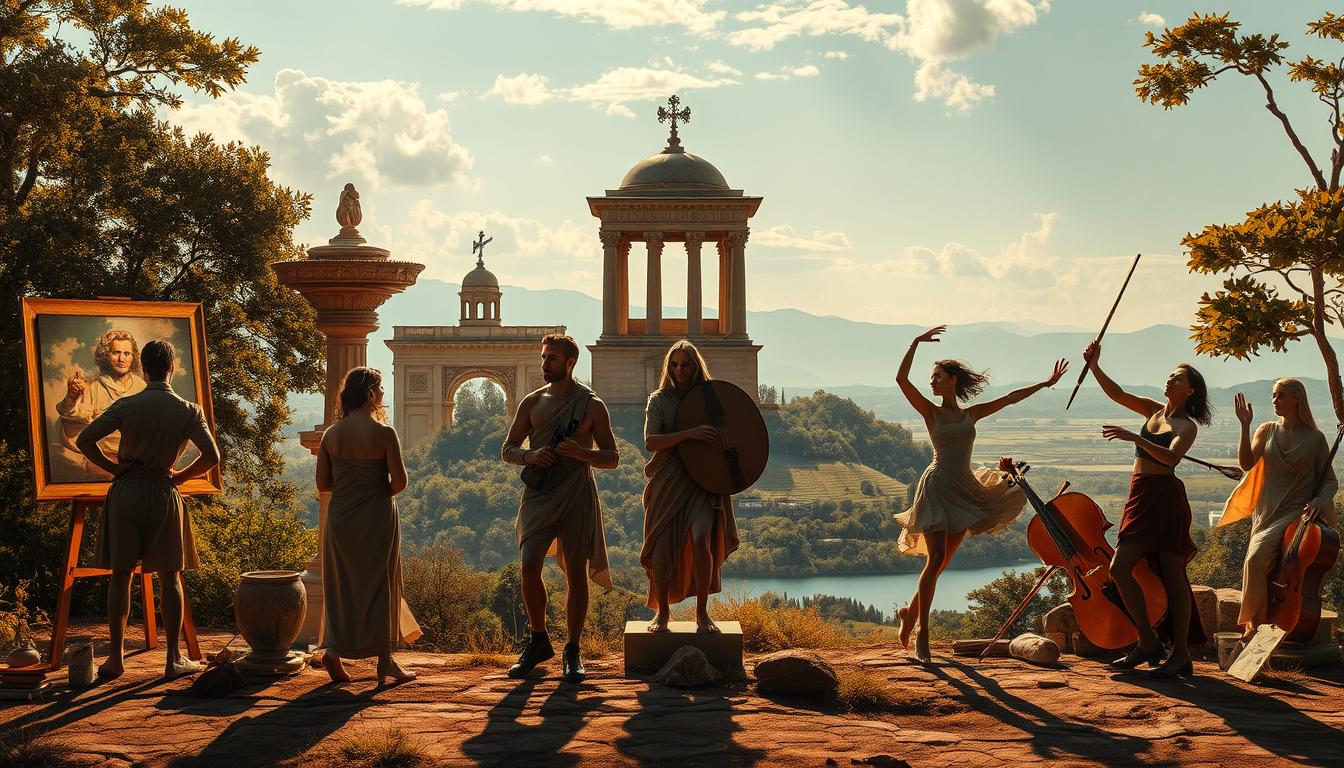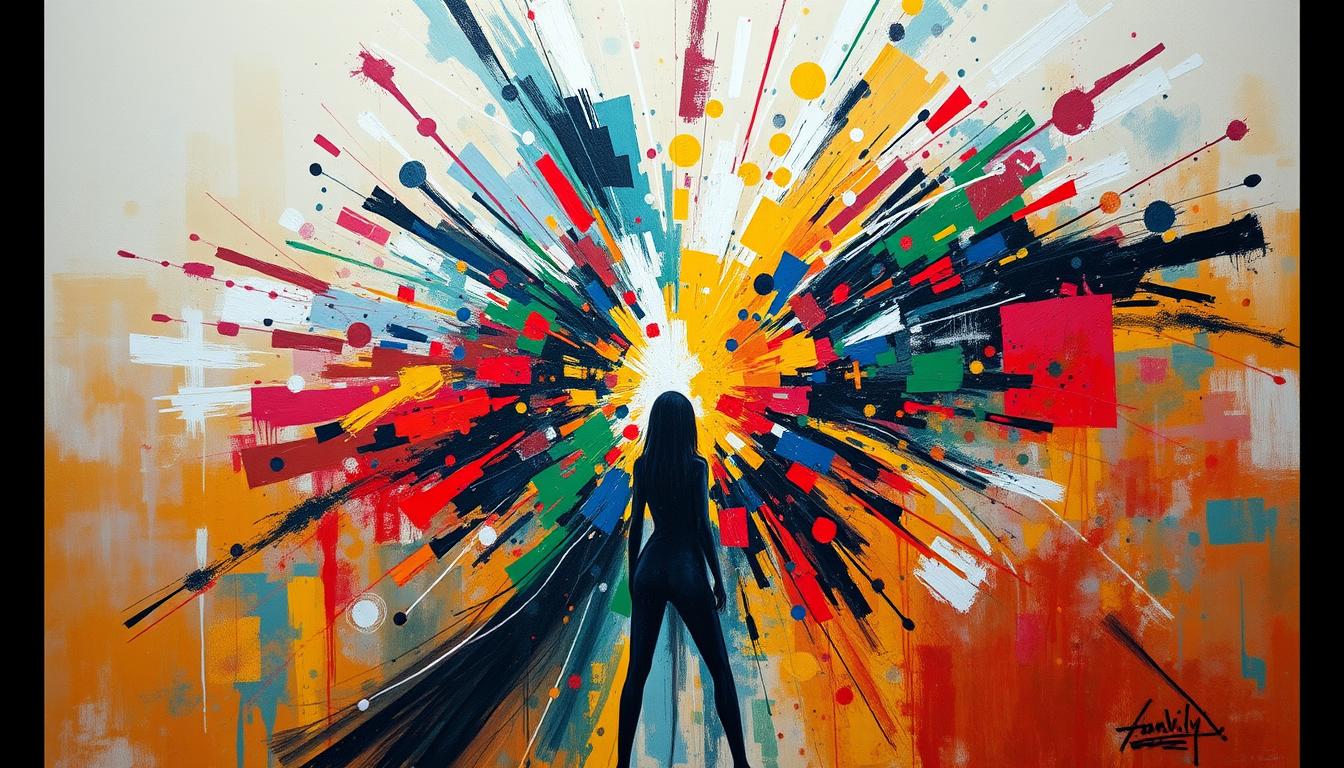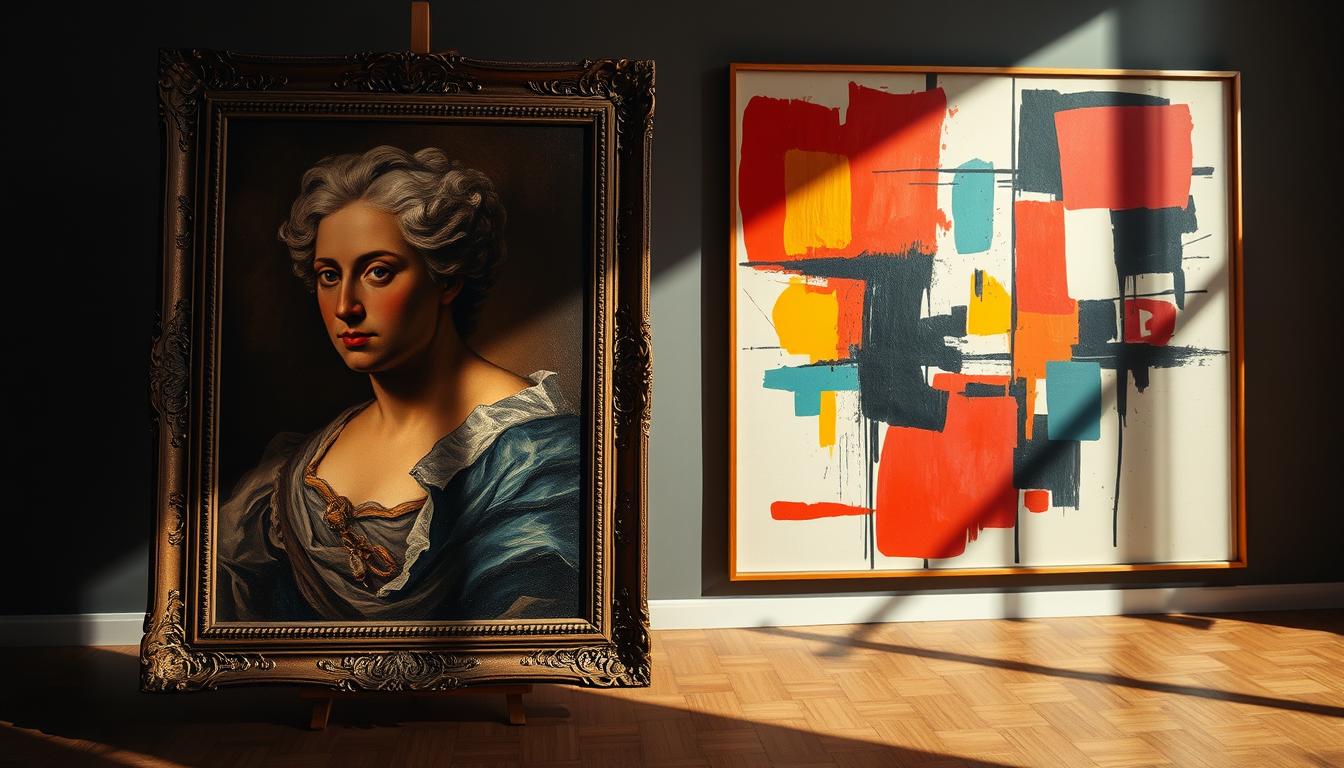Curious which seven creative paths shaped how people view beauty and meaning? This brief tour names each: painting, sculpture, architecture, literature, theatre, film, and music.

Fine art in the art world focuses on aesthetic and cultural value rather than utility. Over time, practices like paintings moved from craft to recognized disciplines. Artists such as Jan van Eyck helped that shift by asserting authorship and originality.
Each form communicates ideas and feelings in its own way. Many artists work across multiple disciplines, mixing music with film or sculpture with architecture. These arts reflect people, places, and periods, giving us a living record of history and culture today.
This article will unpack each form with plain-English definitions and clear examples. Expect a friendly guide that links big ideas to everyday appreciation and invites you to notice what moves you.
Key Takeaways
- The seven most cited forms: painting, sculpture, architecture, literature, theatre, film, music.
- Fine art values aesthetic and cultural expression over utility.
- Recognition of visual arts grew from the Renaissance and artist authorship.
- Artists often cross forms, and each form speaks in different ways.
- Fine arts offer insight into culture, history, and personal feeling.
- The article will give clear definitions and real-world examples.
From Liberal Arts to Fine Arts: How the “Seven” Took Shape
The path from medieval study halls to modern museums shows how some crafts rose into celebrated creative fields.
In medieval Europe, the Liberal Arts meant Grammar, Logic, Rhetoric, Arithmetic, Geometry, Astronomy, and Music. Those subjects formed a core of education and shaped early ideas about knowledge and history.
At that time, visual practice like painting and sculpture lived in workshops and guilds. Works were often unsigned and seen as skilled craft rather than autonomous visual art.
A turning point came when Jan van Eyck signed the Arnolfini Portrait. That gesture marked authorship and helped swing perception toward individual creators. The Renaissance idea of disegno interno further elevated the maker’s inner idea.
In the 19th century, Théophile Gautier argued for "art for art's sake," insisting that fine art holds value without function. Later, scholars like Vera Zolberg showed how exhibitions and debate shape status in the art world.
- Education and museums helped formalize the modern list used today.
- Debates and new techniques let film, architecture, and music join the canon.
- Over time, development across media made a coherent set of seven creative fields.
"Duchamp’s Fountain and later shows proved that institutions often decide what counts as art."
What are 7 fine arts? A clear list with definitions and examples
This list pairs each major creative form with a plain definition and a quick example. Read short entries to see materials, methods, and how artists shape meaning across media.
Painting
Painting makes images with oil, acrylic, or watercolor on a prepared surface such as canvas, wood panel, or metal.
Techniques like layering, glazing, and drawing with graphite or charcoal shape the composition and mood of paintings.
Sculpture
Sculpture produces three-dimensional forms in marble, wood, bronze, or modern media like 3D printing and electronics.
Ready-mades and found objects widened the idea of sculptures, letting everyday items become art through intent.
Architecture
Architecture designs structures that serve use and convey culture. Gothic cathedrals and Gehry’s Guggenheim Bilbao show how structures carry meaning.
Literature
Literature uses words—poetry, prose, drama—to express ideas and feeling. Writing lives on the page and in spoken performance.
Theatre
Theatre is live performance that mixes script, acting, stage design, lighting, and sometimes dance. Collaboration brings each work to life in front of people.
Cinema/Film
Film tells stories with moving images, montage, sound, and design. Filmmakers combine writing, directing, and acting to shape cinematic experience.
Music
Music arranges sound in time using voice and instruments. From ancient instruments to pop, music often centers on live performance and shared feeling.
"Each form stands alone yet joins others when artists mix media."
The evolution of art forms: materials, media, and the contemporary art world
Materials shape practice and meaning. A tempera panel dries fast and keeps crisp marks, while oil mixed with linseed or walnut oil lets painters blend slowly and build luminous depth over time. Van Eyck's work helped oil painting reach new naturalism, changing how paintings looked and aged.
Acrylic changed the rules for modern painting. It dries fast, cleans with water, and bonds to many surfaces. That versatility made new approaches possible on canvas, panel, and even unconventional surfaces.

From craft to concept: technology, readymades, and installation shaping today
Sculpture moved from carved marble and cast bronze to mixed media. Artists now combine metal, wood, resin, plexiglass, and electronics. 3D printing and digital fabrication let makers prototype complex forms quickly.
Drawing in charcoal or chalk still underpins many projects. Quick studies and careful underdrawings guide both painting and sculpture on a chosen surface.
- Readymades like Duchamp’s Fountain changed what counts as object-based work.
- Installation expanded three-dimensional practice into immersive environments.
- Conservation and display decisions follow material choices and affect museums today.
| Material | Typical Use | Key Advantage | Conservation Concern |
|---|---|---|---|
| Oil | Paintings | Slow blending, depth | Yellowing, varnish aging |
| Acrylic | Contemporary painting | Fast drying, versatile surface | Plasticization over time |
| Bronze / Marble | Sculpture | Durable, traditional prestige | Corrosion, surface erosion |
| Resin / Electronics | Mixed-media sculpture & installation | Lightweight, programmable effects | Material instability, obsolescence |
Today, the art world accepts a wide range of materials so long as concept and craft align. Many contemporary works blend painting with sculpture, or pair objects with sound and projection. For a broader look at visual practices, see this overview of visual art.
"Materials both preserve tradition and expand what art can be."
How the seven art forms intersect: visual, literary, and performing arts in dialogue
Crossing boundaries, several art forms mix language, sound, and space to shape experience. Theatre often blends literature’s script and poetry with music’s score and dance’s movement to make a single live performance that depends on audience reaction.
Film borrows poetry’s cadence in voice-over, painting’s color choices in cinematography, and music’s timing to guide emotion. Directors and composers work together to time beats and edits so the narrative lands.
Choreographers and composers collaborate regularly: dance interprets music physically while spoken-word poets layer added expression. Designers use lighting and stage structures to guide focus, echoing architectural logic in temporary sets.

- Sculptures can become props or installations inside performance, blurring static and time-based work.
- Writers direct films; visual artists stage performances; musicians compose for galleries—people move across form boundaries.
- Shared language — composition, rhythm, motif, contrast — helps artists build cohesive pieces across media.
"Collaboration creates works no single form could achieve alone, expanding what fine art can communicate."
Interdisciplinary projects also widen audiences by offering many entry points — sound, image, or movement — and keep the arts ecosystem lively. For a broader look at overlapping practices, see this overview of the arts.
Conclusion
The seven main creative types give us clear ways to read work across centuries and cultures.
Each form — from architecture and painting to music, literature, theatre, and film — offers a distinct way to shape meaning for people today.
History shows how study and practice moved skills into recognized fields. Support for education and local programs keeps techniques alive and helps artists innovate over the years.
Visit a gallery, catch a performance, or join a class to see how pieces combine idea and craft. Mixed projects that blend types prove the system still matters.
Long-term interest, patronage, and learning ensure access and fresh work for future generations. Explore, reflect, and support the arts in your community.
Enhance Your Space with Unique Modern Masterpieces
Are you inspired by the innovative mediums and conceptual depth highlighted in our exploration of contemporary art? You’re not alone! Today’s art enthusiasts are seeking cultural relevance and emotional connections in their artwork. However, finding pieces that resonate with modern themes and fit your unique style can be a challenge. That’s where we come in!
At Rossetti Art, we specialize in canvas prints, original paintings, and modern sculptures that celebrate the spirit of now. Each piece created by Chiara Rossetti brings a personal touch that connects deeply with current social narratives—just like the modern masterpieces discussed in the article. Don’t miss out on the chance to elevate your home decor with breathtaking artwork that speaks to your values and aesthetic. Explore our collection today and find your perfect piece! Act now, and transform your space into a gallery of inspiration!
FAQ
What is meant by the seven traditional arts?
The traditional list groups painting, sculpture, architecture, literature, theatre, film, and music as distinct creative disciplines. Each one uses different media—brush and canvas, carved stone, built space, written words, staged performance, moving image, and organized sound—to express ideas, emotions, and cultural values.
How did the concept move from medieval liberal arts to these disciplines?
Medieval education focused on the liberal arts—grammar, rhetoric, logic and so on—while the modern list grew from 18th- and 19th-century debates about aesthetics. Critics and theorists shifted attention from utility and craft to aesthetic experience, giving visual and performing arts elevated cultural status and forming the familiar seven-part grouping.
Why did visual art gain prestige with the “art for art’s sake” idea?
The late 19th-century slogan emphasized autonomy and beauty over moral or practical use. Artists such as Édouard Manet and theorists like Théophile Gautier helped popularize the notion that art’s value could be intrinsic, which raised the social standing of painting, sculpture, and other visual practices.
What kinds of painting techniques and supports are common?
Painting includes oil, acrylic, and watercolor applied to canvas, wood panel, paper, and experimental surfaces. Artists use brushes, palette knives, and mixed media to build color, texture, and composition, from representational work to abstraction.
How has sculpture changed in materials and methods?
Sculpture began in stone and bronze but expanded to wood, metal, clay, fabric, and found objects. Contemporary sculptors like Anish Kapoor and Louise Bourgeois use installation, kinetics, and new media to challenge scale, space, and viewer interaction.
What defines architecture as an art form as well as a utility?
Architecture combines functionality with aesthetics, shaping environments that reflect culture, technology, and ideology. Architects such as Frank Lloyd Wright and Zaha Hadid illustrate how structure, material, and form can create symbolic and experiential meaning beyond shelter.
How does literature fit into the list of artistic disciplines?
Literature uses narrative, lyric, and dramatic forms—novels, poems, and plays—to explore language, identity, and thought. Writers like Toni Morrison and Gabriel García Márquez show how prose and poetry craft complex ideas and emotional depth.
What distinguishes theatre from other performing arts?
Theatre centers on live action and spoken text, often combining movement, set design, and sound to convey story and character. It overlaps with dance and performance art but remains rooted in the immediacy of the stage and audience exchange.
Why is film considered a collaborative and hybrid art?
Film merges visual composition, narrative, sound, performance, and editing into a time-based medium. Directors like Alfred Hitchcock and Agnes Varda orchestrate cinematography, music, and montage to produce works that rely on many specialized crafts.
How broad is the category of music within the seven forms?
Music arranges sound over time using voice and instruments across genres from classical symphony to jazz, rock, and electronic. Composers and performers such as Ludwig van Beethoven, Duke Ellington, and Björk demonstrate music’s range as emotional and social expression.
How have materials and media transformed contemporary practice?
New technologies, readymades, and installation art expanded what counts as art. Digital tools, video, performance, and conceptual strategies challenge traditional craft boundaries, allowing artists to prioritize idea, experience, and context as much as material skill.
In what ways do these disciplines intersect today?
Collaboration across visual, literary, and performing arts is common. Films adapt novels; composers score theatre; architects work with visual artists on installations. Cross-disciplinary practice enriches form and invites audiences to experience layered meanings.






Leave a comment
This site is protected by hCaptcha and the hCaptcha Privacy Policy and Terms of Service apply.